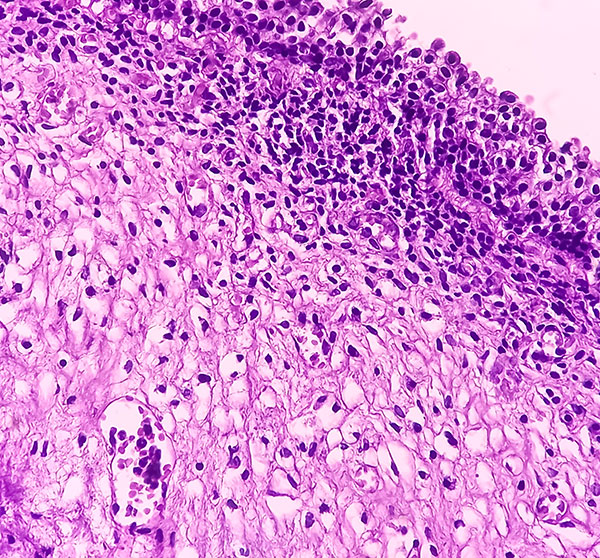References
Action Bladder Cancer (2025) Diagnosis. https://actionbladdercanceruk.org/diagnosis/ (accessed 2 May 2025)
Cancer Research UK (2025a) What is bladder cancer? https://www.cancerresearchuk.org/about-cancer/bladder-cancer/about (accessed 2 May 2025)
Cancer Research UK (2025b) Types of bladder cancer. https://www.cancerresearchuk.org/about-cancer/bladder-cancer/types-stages-grades/types (accessed 8 May 2025)
Cancer Research UK (2025c) Symptoms. https://www.cancerresearchuk.org/about-cancer/bladder-cancer/symptoms (accessed 8 May 2025)
Cancer Research UK (2025d) Stages of bladder cancer. https://www.cancerresearchuk.org/about-cancer/bladder-cancer/types-stages-grades/stages (accessed 8 May 2025)
European Association of Urology (2025a) Non-muscle-invasive Bladder Cancer. Diagnosis. https://uroweb.org/guidelines/non-muscle-invasive-bladder-cancer/chapter/diagnosis (accessed 7 May 2025)
European Association of Urology (2025b) Muscle-invasive and Metastatic Bladder Cancer. Diagnostic evaluation. https://uroweb.org/guidelines/muscle-invasive-and-metastatic-bladder-cancer/chapter/diagnostic-evaluation (accessed 7 May 2025)
European Association of Urology (2025c) Non-muscle-invasive Bladder Cancer. Disease management. https://uroweb.org/guidelines/non-muscle-invasive-bladder-cancer/chapter/disease-management (accessed 7 May 2025)
European Association of Urology (2025d) Muscle-invasive and Metastatic Bladder Cancer. Disease management. https://uroweb.org/guidelines/muscle-invasive-and-metastatic-bladder-cancer/chapter/disease-management (accessed 7 May 2025)
National Institute for Health and Care Excellence (2015a) Diagnosing and staging bladder cancer. https://www.nice.org.uk/guidance/ng2/chapter/Recommendations#diagnosing-and-staging-bladder-cancer-2 (accessed 7 May 2025)
National Institute for Health and Care Excellence (2015b) Treating non-muscle-invasive bladder cancer. https://www.nice.org.uk/guidance/ng2/chapter/Recommendations#treating-non-muscle-invasive-bladder-cancer-2 (accessed 7 May 2025)
National Institute for Health and Care Excellence (2015c) Treating muscle-invasive bladder cancer. https://www.nice.org.uk/guidance/ng2/chapter/Recommendations#treating-muscle-invasive-bladder-cancer-2 (accessed 7 May 2025)
Cancer Research UK (2025a) What is bladder cancer? https://www.cancerresearchuk.org/about-cancer/bladder-cancer/about (accessed 2 May 2025)
Cancer Research UK (2025b) Types of bladder cancer. https://www.cancerresearchuk.org/about-cancer/bladder-cancer/types-stages-grades/types (accessed 8 May 2025)
Cancer Research UK (2025c) Symptoms. https://www.cancerresearchuk.org/about-cancer/bladder-cancer/symptoms (accessed 8 May 2025)
Cancer Research UK (2025d) Stages of bladder cancer. https://www.cancerresearchuk.org/about-cancer/bladder-cancer/types-stages-grades/stages (accessed 8 May 2025)
European Association of Urology (2025a) Non-muscle-invasive Bladder Cancer. Diagnosis. https://uroweb.org/guidelines/non-muscle-invasive-bladder-cancer/chapter/diagnosis (accessed 7 May 2025)
European Association of Urology (2025b) Muscle-invasive and Metastatic Bladder Cancer. Diagnostic evaluation. https://uroweb.org/guidelines/muscle-invasive-and-metastatic-bladder-cancer/chapter/diagnostic-evaluation (accessed 7 May 2025)
European Association of Urology (2025c) Non-muscle-invasive Bladder Cancer. Disease management. https://uroweb.org/guidelines/non-muscle-invasive-bladder-cancer/chapter/disease-management (accessed 7 May 2025)
European Association of Urology (2025d) Muscle-invasive and Metastatic Bladder Cancer. Disease management. https://uroweb.org/guidelines/muscle-invasive-and-metastatic-bladder-cancer/chapter/disease-management (accessed 7 May 2025)
National Institute for Health and Care Excellence (2015a) Diagnosing and staging bladder cancer. https://www.nice.org.uk/guidance/ng2/chapter/Recommendations#diagnosing-and-staging-bladder-cancer-2 (accessed 7 May 2025)
National Institute for Health and Care Excellence (2015b) Treating non-muscle-invasive bladder cancer. https://www.nice.org.uk/guidance/ng2/chapter/Recommendations#treating-non-muscle-invasive-bladder-cancer-2 (accessed 7 May 2025)
National Institute for Health and Care Excellence (2015c) Treating muscle-invasive bladder cancer. https://www.nice.org.uk/guidance/ng2/chapter/Recommendations#treating-muscle-invasive-bladder-cancer-2 (accessed 7 May 2025)



